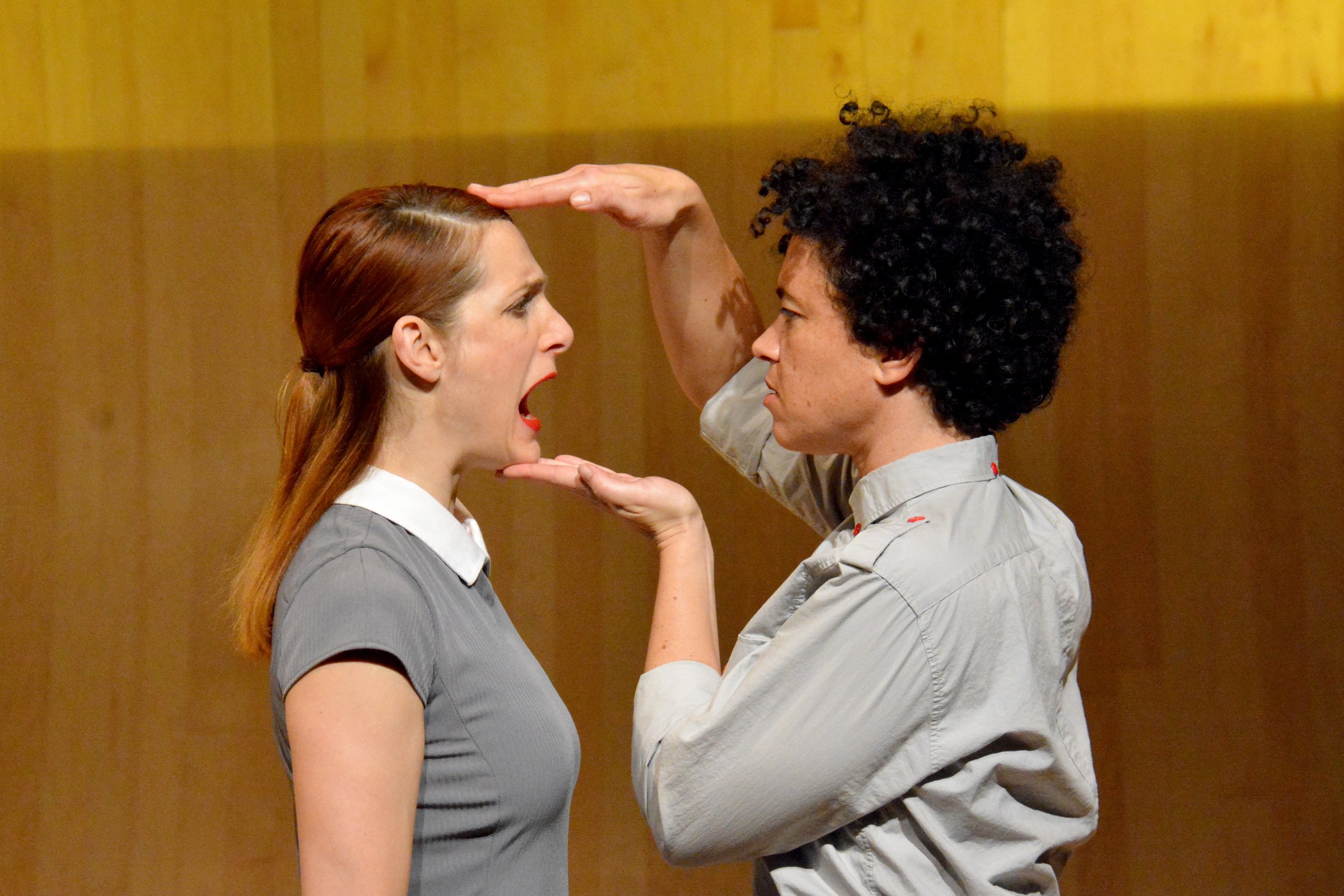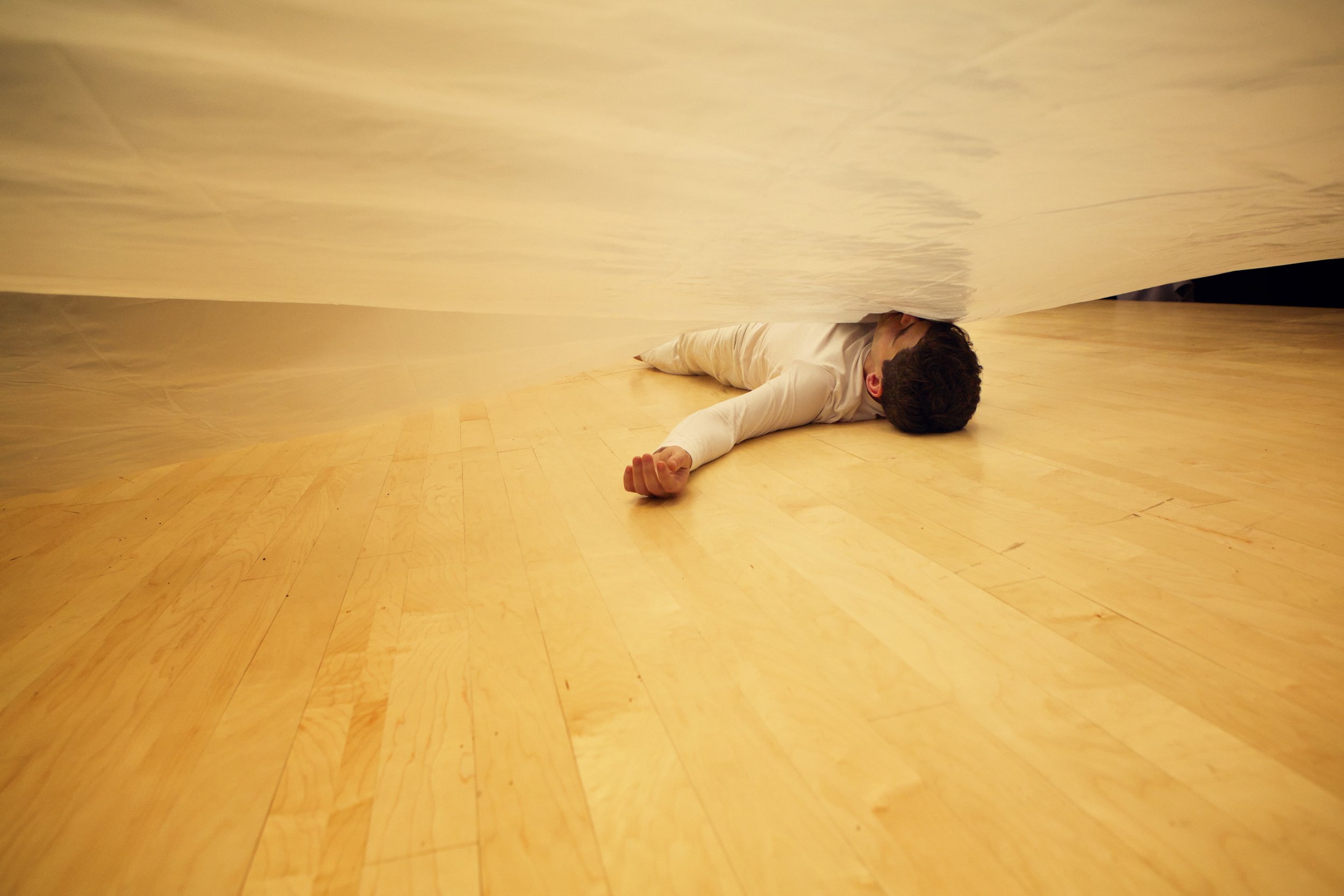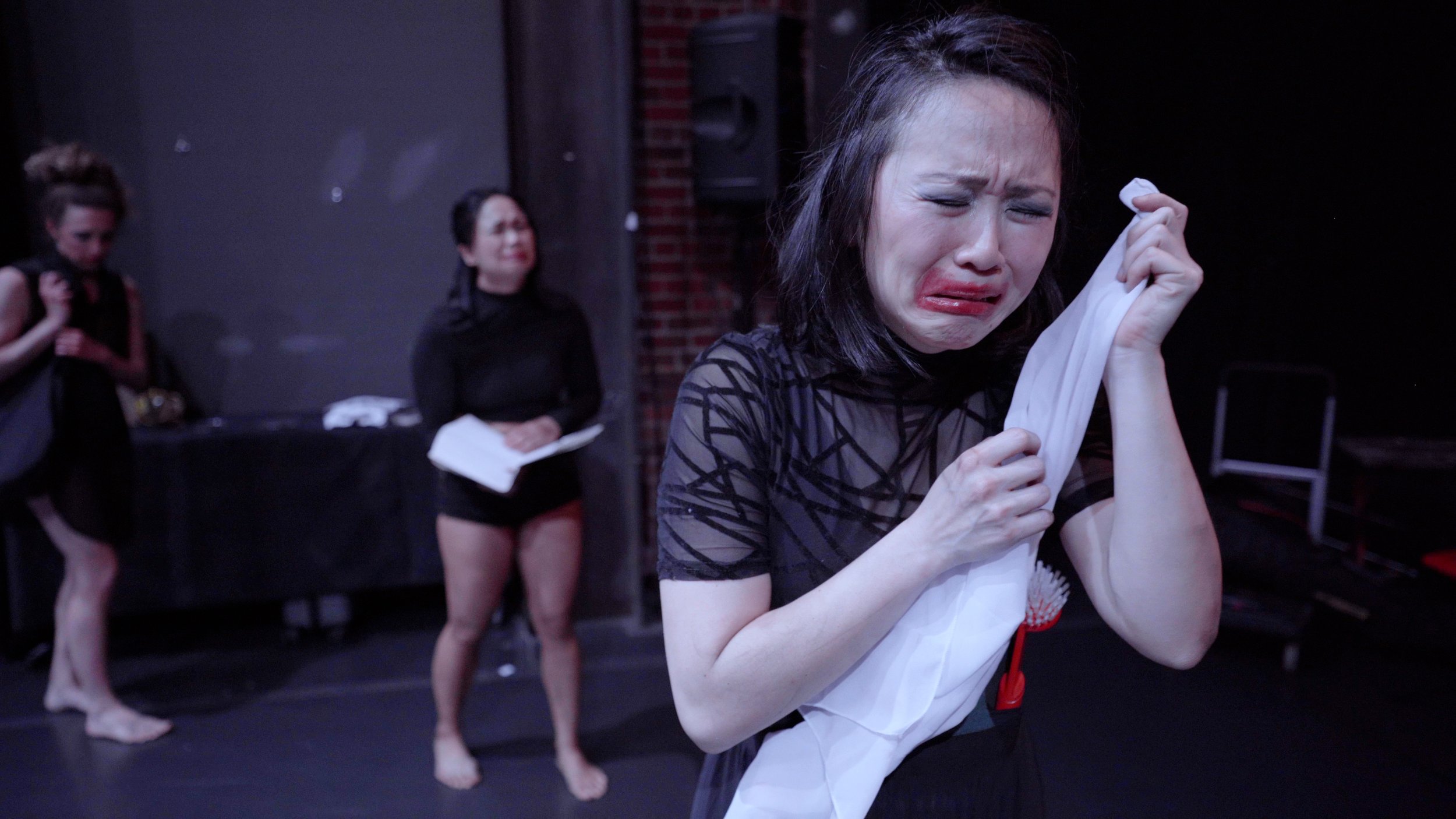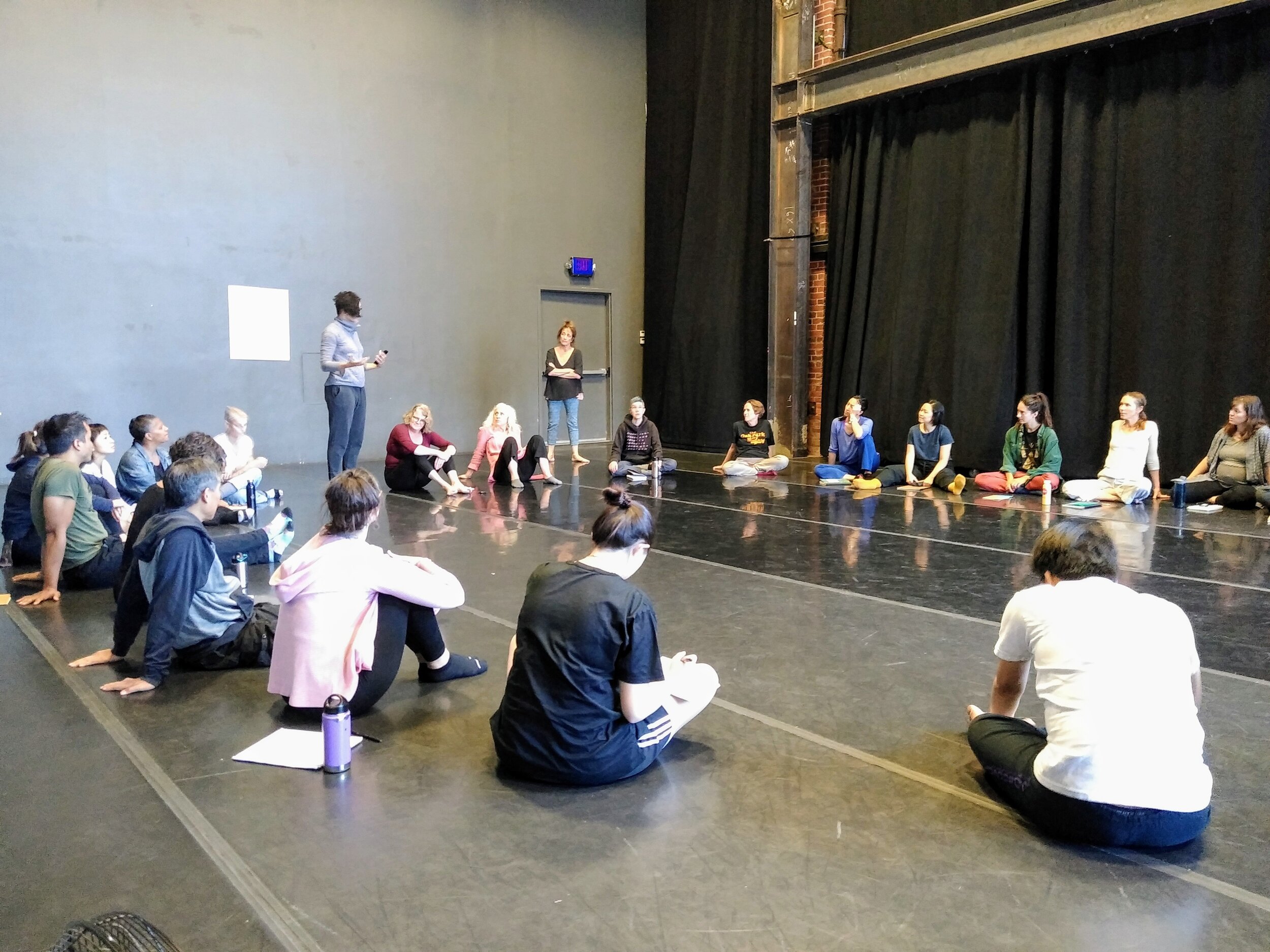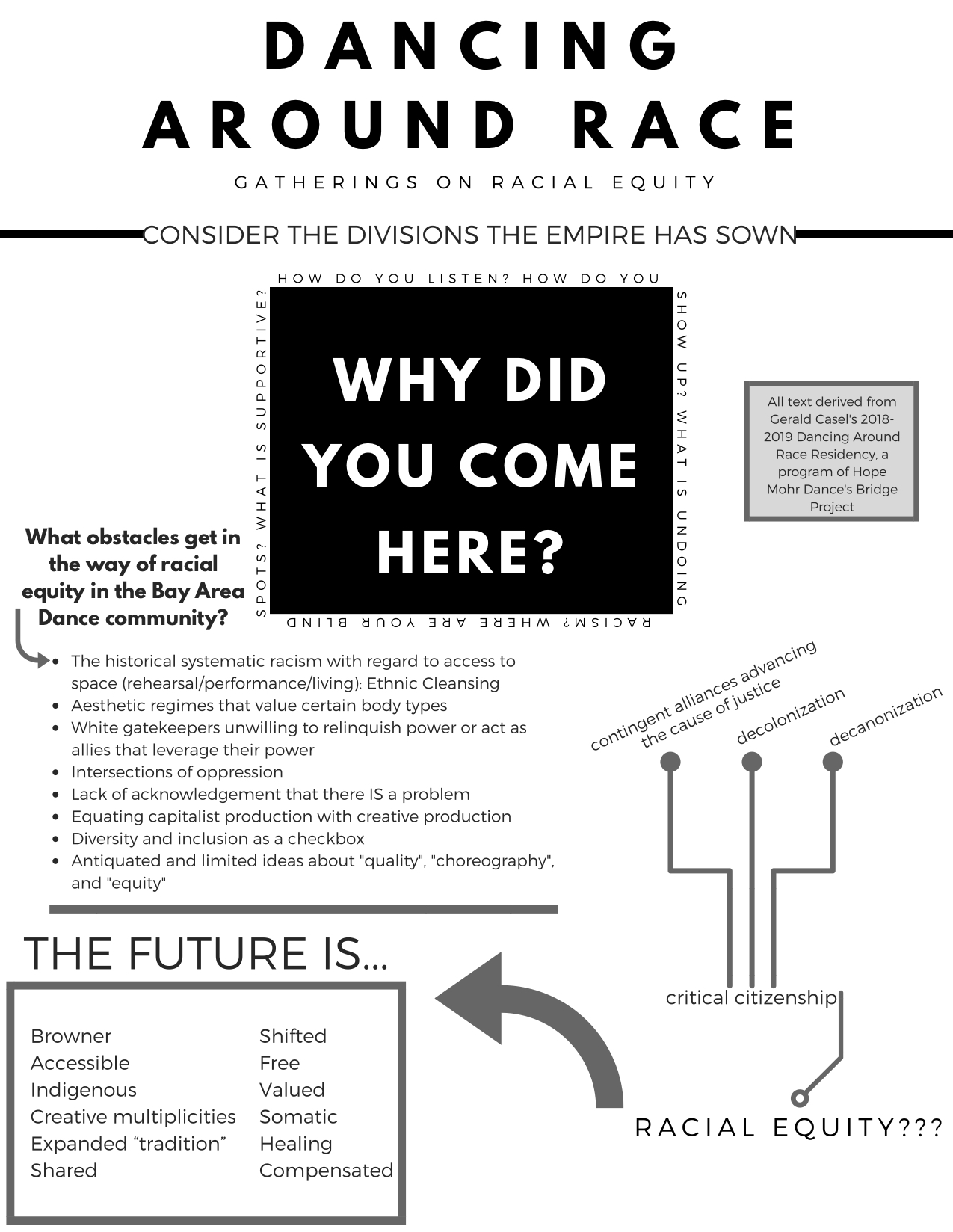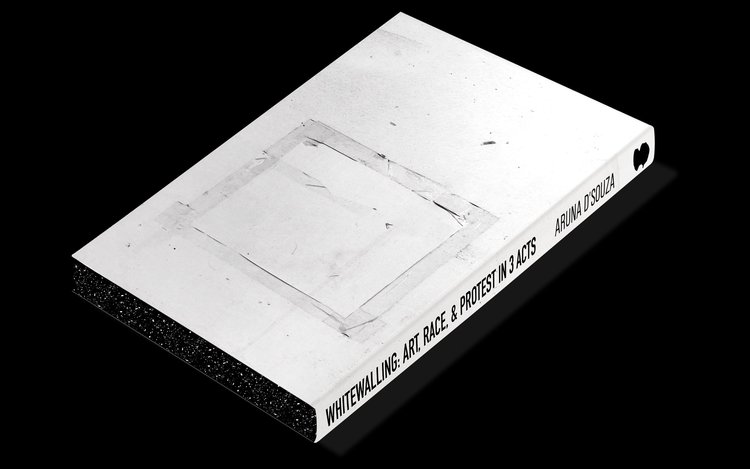This essay was originally published by The Back Room, a project of Small Press Traffic, on October 4, 2023. Special thanks to editor Claudia LaRocco.
We learn to speak as we separate from our mother. Perhaps we learn to speak because we separate from her. Perhaps we separate from her so that we can learn to speak.
Language “creates a parceled body, a sense that the body is in pieces. Language divides the subject from the organism.” (Annie Rogers)
The body/language split lives in me as an inarticulate sensation, an amorphous feeling, an unconscious angle on the world.
I make dance in conversation with language to metabolize this split and to move toward a unified self — a self not predicated on renouncing my body.
In 2013, I made a dance called Failure of the Sign is the Sign. I made it when my daughter was six and my son was four. I was so exhausted; I don’t remember making it. The set, by Katrina Rodabaugh, featured soft blue sculptures resembling body parts, some suspended, others on the ground, which the dancers wrapped themselves in as they vocalized and moved. These sculptures represented Donald Winnicott’s “transitional objects,” items children create to comfort themselves while separating from a primary caregiver. The dancers did not speak, but instead made raw, abstract sounds — “magic without meaning.” (Toni Morrison) Sighs, grunts, moans. Language as meaning was present only in the voiceover, a recording of a text I wrote keyed to the alphabet. The end of the text was:
V is for the void we avoid
W is for what do you want to be when you grow up
W is for wide awake waiting to be asked
W is for what you and your mother have in common
X is for a little exit problem
Y is for you don’t have to be perfect
Z is for when the repetitions of childhood end
My goal in working with source texts is not fidelity to source, but to filter that source through the body to imagine a world. Making dance in dialogue with text, I reckon with different aspects of language: its meaning, its music, its grammar, its feeling. Alternating between dance and text creates a third thing. Tere O’Connor talks about choreography as an unearthing of idea, not a coming from idea. Dancing in conversation with language is a non-linear combination of finding and making, a dialectic through which I unearth idea.
Performance is an invitation into full presence. Wiley Naman Strasser (L) and Christian Burns in Leaving the Atocha Station.
Recently I said to my sixteen-year-old daughter: I am a bad feminist. She said, What’s a bad feminist — I thought you were either a feminist or not. I said, A bad feminist is someone who calls herself a feminist but also hates herself. A wan smile flickered at the side of her mouth.
The central conundrum of a split self: what subjugates me also constitutes me. If I want liberation from what subjugates me, I also want liberation from myself. And so, in order “for desire to triumph, the subject must be threatened with dissolution.” (Judith Butler)
Ambivalence haunts me. Dancing brings me relief; so does good sex. Oddly, so does mothering.
In Ben Lerner’s novel Leaving the Atocha Station, a poet crippled by doubt longs to disappear into numbness and addiction: “my body was dissolved, and that’s all I’d ever really wanted from my body, such as it was.” The protagonist is unable to be in his body even while participating in political protest. But he secretly believes in the power of art.
In 2019, when I made a dance-theater piece inspired by Lerner’s novel, I cast the performance as a duet featuring Christian Burns and Wiley Naman Strasser to lean into the book’s central tension of a split self.1 The work began with a long gestural sequence in which the performers mirrored each other, reaching out, goading, recoiling. I wanted every action to register as intimacy and self-commentary.
Lerner’s stream-of-consciousness novel is akin to poetry — porous, discursive. It was not written for the stage (mostly internal monologue, little action in the traditional sense). We turned core questions from the text into physical images, scores for improvisation, and prompts for devising material, finally layering text back in. Sometimes, we let physical material stand alone; passages about addiction became a long game with dozens of pill bottles on stage.
The novel is also relentlessly self-referential, so I wanted the book on stage as an object. Sometimes a performer would deliver a memorized passage while holding the book, but not looking at it. I liked this tension. I liked leaving the audience to wonder where the language lived.
A split self has benefits. You can see the world from multiple angles. You can see the fractured nature of things. You can see with an outsider’s eye. You can believe that no one will ever know you because part of you hides elsewhere.
And yet the dance of the split self takes you away from being fully present. It is a form of suffering rooted in the delusion that there is a self to begin with. Being preoccupied with our self “is like being deaf and blind. It’s like standing in the middle of a vast field of wildflowers with a black hood over our heads.” (Pema Chödrön)
How do I dance in dialogue with text without re-inscribing a split self?
At the end of the novel, the protagonist reads his poetry at a gallery. At the end of the performance, Wiley stood centerstage, looking at Lerner’s book on a music stand. Christian sat in the audience.
The conflict does not resolve. There is no catharsis.
And yet. This ending suggests the potential that performance has to help us exit the loop of ambivalence.
The body complicates narrative. Monique Jenkinson (L) and Rami Margron in Antigonick (2015). Photo: Pak Han.
Imagine a performer delivering a monologue about a decision to follow her desire when the price of doing so is death. Now imagine the performer dancing while she speaks. Or before, or after — the timing of the overlay affects the meaning. How her body moves in relationship to what she says conveys subtext and conflict. Her words say one thing; her body says another.
The body gestures to the vastness beyond words. It adds ambiguity.
Dance and language “reach toward the ineffable” (Toni Morrison) in different ways. They activate distinct parts of the brain. The two can undercut each other or add cognitive dissonance. Meaning can knock between dance and text, illuminating both.
Anne Carson’s use of white space does what the body does. She loves the silence around words. She values the untranslatable. Repeatedly, I’ve returned to Carson as inspiration because her irreverent distillations take source material to the brink of abstraction. I’ve worked with three Carson texts that explore the struggle for a unified self. Her Antigonick and Bakkhai are dramas of people longing to follow desire in a world that doesn’t allow it; her translations of Sappho offer the promise of experiencing a self unified through ecstasy.
Carson’s texts are themselves split, mixing ancient source material with contemporary referents and thereby straddling multiple times. In Carson’s version of Sophocles’s Antigone, Antigonick, she adds a new character: the mute figure of Nick. Nick never leaves the stage. He marks time (“in the nick of time”). I co-directed Antigonick for Shotgun Players in 2015 with Mark Jackson. In our production, the dancer playing Nick (Parker Murphy) painstakingly walked on tiptoe around the perimeter of the stage, an embodied metronome providing a sense of accountability, of forces beyond the other players. His wordless presence did crucial work, complicating narrative time.
You know when you’re in a doomed relationship, but you’re going about daily life, not saying anything about the hidden knowledge in your stomach? That’s embodied time troubling narrative time. Parker Murphy as Nick in Antigonick (2015). Photo: Pak Han.
In Euripedes’s Bakkhai, the authoritarian (and closeted, in Carson's version2) King Pentheus longs to join the bakkhai, women who run wild in the mountains under the spell of the sensual god Dionysus. But Pentheus is a split self. He refuses to honor Dionysus. In retaliation, Dionysus lures Pentheus to the bakkhai; among them is Pentheus’s own mother, Agave, who kills Pentheus in a Dionysian fugue, mistaking him for an animal.
In 2021, I co-directed Bacchae Before, a trans-centered version of Carson’s translation, in collaboration with Maxe Crandall, Mike Chin, Karla Quintero, Belinda He, Wiley Naman Strasser, and Maria Silk. We leaned into parallels between Pentheus’s rigidity and the dominant culture’s love affair with the gender binary; an abstracted gender-reveal party doubled as a bacchanal. The performers moved back and forth between narrative time and hybrid states that bridged sensation and speech.
Blurring the line between dancing and language challenges the patriarchal social order, which, as Carson writes in The Gender of Sound, finds “something disturbing or abnormal about […] meaning from inside the body which does not pass through the control point of logos, a meaning which is not subject to the mechanism of dissociation […] or self-control.”
Longing for becoming can have catastrophic results. Wiley Naman Strasser (L) and Belinda He in Bacchae Before. Photo: Robbie Sweeny.
Euripides intertwines the stability of the patriarchy with adherence to gender roles. The play says: if you listen to desire, there will be consequences. Who pays? The mother.
The play of desire, freedom, and loss unfolds in tragedies of contemporary life. Recently, my passionless marriage of twenty years ended. I now see my children only half the time.
Bacchae Before ends with grief. Agave dances her wild sorrow. A long list of anti-trans legislation scrolls against the back wall.
Faced with little space for radical longing, we must turn to the truth of our own bodies as the ground for re-imagining our lives.
Some language is a beacon for the practice of trusting desire. L to R: Karla Quintero, Jane Selna, Suzette Sagisi, and Tara McArthur in extreme lyric I (2018). Photo: Robbie Sweeny.
Sappho offers the elusive possibility of unifying — and losing — the self through ecstasy. In 2018, I collaborated with Maxe Crandall, Karla Quintero, Suzette Sagisi, Jane Selna, and Tara McArthur to co-create extreme lyric I, a “dance play” inspired by Carson’s translations of Sappho.
In Sappho, story is almost entirely absent. Image, emotion, and rhythm create worlds. Her fragments, and the silences surrounding them, invite us to crossover into embodiment.
My choreography was an armature for falling into lyric time. Set material provided points of departure for the dancers to get lost in improvisation and sensation. I derived movement phrasing (the way movement spools out in time) from syllabic rhythms in each fragment’s syntax. These rhythms became footfalls and clapping, which we then accelerated or exploded into formlessness. Sappho’s meter led to an experience of non-metered time: form as a path to liberation from form.
Loss and freedom go hand in hand. L to R: Tegan Schwab-Alavi, Suzette Sagisi, and Belinda He in Horizon Stanzas. Performance still courtesy of Loren Robertson Productions.
This past year, I made dance in dialogue with Alice Notley’s grammar as a generative constraint. Wanting to break out of old structures, I turned to The Descent of Alette to push against the predictable ebb and flow of choreographic timing (in dance there are default relationships to time — phrasing keyed to music (4/4) or to gravity or the weight of the body).
The Descent of Alette is a feminist journey through an underworld to vanquish an archetypal tyrant. The tyrant is everywhere, in everyone. Notley asks: “He owns form,” “doesn’t he?” “The tyrant” “owns form?”
The Descent of Alette re-imagines the epic poem, a form historically dominated by men. One of Notley’s tactics in this re-imagining is her aggressive use of quotations, creating a stilted music. Her fractured text differs from Sappho’s fragments, which are surrounded by silence: you have to imagine the whole. In Notley’s poem, although quotation marks splinter the page, the whole is all there.
I mapped Notley’s formal choices onto movement, asking the dancers to stop and start according to quotation marks and line breaks. Then I took the text away, so that the stops in the dance created odd stops inside and around the movement. Unexpected stillness was what I was after.
I called the dance Horizon Stanzas. “What we see when we look toward the horizon is not a limit but an invitation.” (Mike Chin)
On her quest, Alette is helped by an owl who guides her through the necessary process of losing, then re-constituting, her body.
Source texts help me shed what is no longer useful. They help me find my own grammar, “the grammar of a possible life.” (Christina Sharpe)
Having killed the tyrant, Alette emerges from underground into a world in which “the light has been made new.” There the poem ends.
I feel an immense space around me. The wind against my skin.
[1] Christian is a veteran dance improviser and Wiley is a versatile, embodied actor. Casting is a decisive factor in working with dance and language. Many actors are not trained to handle complex choreography; vice versa for dancers and text. Trained to shunt energy into movement, a dancer will often rock back and forth while speaking. Conversely, actors not fully in their bodies may have limited capacity for full body engagement beyond gesture.
[2] Carson, Kay Gabriel argues in “Specters of Dying Empire: The Case of Carson’s Bacchae,” writes Pentheus as a trans figure who cannot admit he would rather live in the “skin of a woman.” Bacchae Before thus responds to transphobia within Carson’s text and in the world. See also Silk Worm, “The Eyes of Others.”


